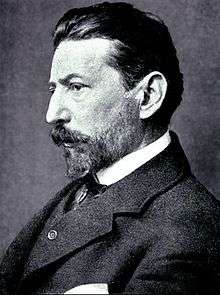Miksa Róth
| Miksa Róth | |
|---|---|
 | |
| Born |
December 26, 1865 |
| Died |
June 14, 1944 |
Miksa Róth (December 26, 1865 – June 14, 1944) was a Hungarian mosaicist and stain glass artist responsible for making mosaic and stained glass prominent art forms in Hungarian art.[1][2] In part, Róth was inspired by the work of Pre-Raphealite artists Edward Burne-Jones and William Morris.[2]
Róth apprenticed at his father, Zsigmond Róth's leaded stain glass studio.[3]Starting a business in 1885, he would make commissions for a number of buildings, largely in Budapest, including the Hungarian Parliament Building and the Buda Castle.[1] Róth also received a number of commissions outside the country as well, for example the National Theatre of Mexico.[1]
References
| Wikimedia Commons has media related to Miksa Róth. |
- 1 2 3 "Etched in glass: The life and works of Hungarian artist, Miksa Róth". Hindustani Times. 2017-10-20. Retrieved 2018-06-27.
- 1 2 Tobin, Thomas J. (2005). Worldwide Pre-Raphaelitism. SUNY Press. pp. 198–199. ISBN 9780791462652.
- ↑ Móra, Imre (2001). Budapest then and now. New World Pub. p. 46.
Further reading
- Varga, Vera; Farkas, Ákos; (Hungary), Iparművészeti Múzeum; Palla, Mária (2000). Glass and radiance: iridescent and lustered glass from the second half of the nineteenth century to the 1910's in the collection of the Museum of Applied Arts. Budapest Museum of Applied Arts.
This article is issued from
Wikipedia.
The text is licensed under Creative Commons - Attribution - Sharealike.
Additional terms may apply for the media files.